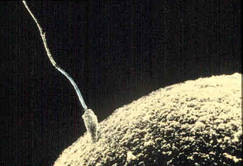At the moment of fertilisation the sperm enters the egg, and things start getting exciting (at least, in biological terms). The following descriptions show what happens in mouse development: we currently do not know whether human development is exactly the same, but it is likely that many events are similar. When the sperm goes in, it reactivates the division process in the egg, causing the arrested chromosome half-sets to separate. The unwanted chromosomes are booted out and form a little cell called the polar body, with no further part to play in the unfolding developmental drama (see figure 1, below). The remaining egg chromosomes organise into a ball-like structure termed a pronucleus. At the same time, proteins in the egg begin to unpack the sperm DNA, expanding it to form another pronucleus (see figure 1, below).
Many epigenetic changes take place while the embryo is still a single cell, and these mainly occur within the sperm pronucleus. These molecular upheavals are essential for reprogramming the sperm, so it can be used correctly in the next steps of development. But the epigenetic adventures don't stop at the one-cell stage. The new embryo divides into two cells, then four, then eight and so on until it is a ball of around a hundred cells (see figure 2). Throughout this flurry of activity, more molecular tags are removed from the DNA while other epigenetic modification patterns are established. Eventually, after 4 to 5 days, the ball of cells begins to take shape. A cavity forms and fills with fluid, pushing the cells outwards until the ball is almost hollow and looks rather like a football. We call this a "blastocyst". But the blastocyst is not quite hollow, because lurking on one side is a small clump of cells, somewhat obviously named the "inner cell mass". It is from this unpromising cluster that we all grew: these are the stem cells of the embryo. It is also clear at this stage that there are distinct epigenetic differences between the outer cells and the inner cell mass.



Its a great pleasure reading your post.Its full of information I am looking for and I love to post a comment that "The content of your post is awesome" Great work. Baby Back Pack
ReplyDelete